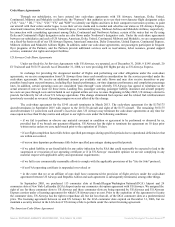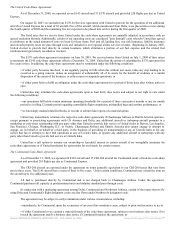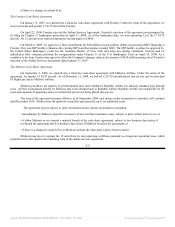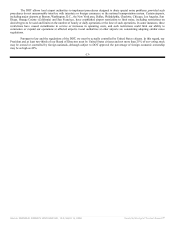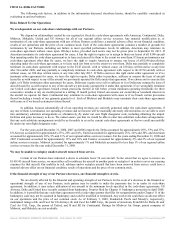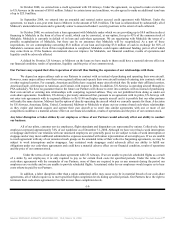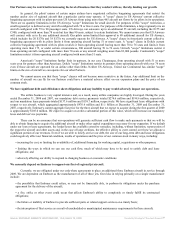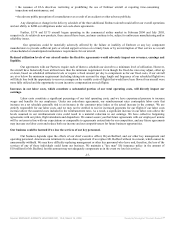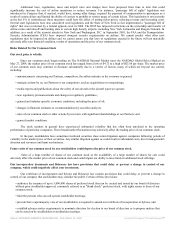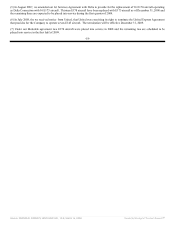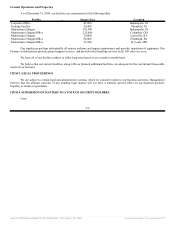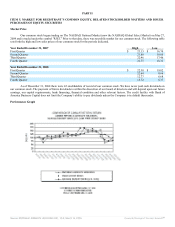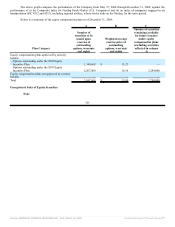Frontier Airlines 2008 Annual Report Download - page 28
Download and view the complete annual report
Please find page 28 of the 2008 Frontier Airlines annual report below. You can navigate through the pages in the report by either clicking on the pages listed below, or by using the keyword search tool below to find specific information within the annual report.
Our Partners may be restricted in increasing the level of business that they conduct with us, thereby limiting our growth.
In general, the pilots' unions of certain major airlines have negotiated collective bargaining agreements that restrict the
number and/or size of regional aircraft that a particular carrier may operate. A "scope" clause in US Airways' current collective
bargaining agreement with its pilots prevents US Airways from using more than 465 aircraft not flown by its pilots in its operations.
There are no quantity limitations in the US Airways "scope" limitations for small aircraft. For purposes of this "scope" restriction, a
small regional jet is defined as any aircraft configured with 78 or fewer seats. For purposes of this limitation, a large regional jet is an
aircraft configured with 79 to 90 passenger seats. US Airways can outsource up to an additional 55 aircraft, including the E175 and
C900, configured with more than 78 seats but less than 90 seats, subject to certain limitations. We cannot assure you that US Airways
will contract with us to fly any additional aircraft. Our pilots union limited their approval to 80 additional aircraft for US Airways,
which includes the 20 E170s and 38 E175s we currently operate for US Airways. A "scope" clause in American's current collective
bargaining agreement with its pilots limits it from operating aircraft having 51 or more seats. A "scope" clause in Delta's current
collective bargaining agreement with its pilots restricts it from operating aircraft having more than 70 to 76 seats and limits it from
operating more than 175, or under certain circumstances, 200 aircraft having 70 to 76 seats. United's "scope" limitations restrict it
from operating aircraft configured with more than 70 seats or any aircraft weighing more than 83,000 pounds. Continental's "scope"
limitations restrict it from operating aircraft configured with more than 51 seats.
American's "scope" limitations further limit its partners, in our case Chautauqua, from operating aircraft with 51 or more
seats even for partners other than American. Delta's "scope" limitations restrict its partners from operating aircraft with over 76 seats
even if those aircraft are operated for an airline other than Delta. Neither US Airways, United nor Continental has similar "scope"
limits on the size of aircraft we can operate for our other Partners.
We cannot assure you that these "scope" clauses will not become more restrictive in the future. Any additional limit on the
number of aircraft we can fly for our Partners could have a material adverse effect on our expansion plans and the price of our
common stock.
We have significant debt and off-balance sheet obligations and any inability to pay would adversely impact our operations.
The airline business is very capital intensive and, as a result, many airline companies are highly leveraged. During the years
ended December 31, 2008 and 2007, our mandatory debt service payments totaled $274.6 million and $198.6 million, respectively,
and our mandatory lease payments totaled $137.6 million and $138.7 million, respectively. We have significant lease obligations with
respect to our aircraft, which aggregated approximately $976.6 million and $1.1 billion at December 31, 2008 and December 31,
2007, respectively. Embraer's current aggregate list price for the three aircraft that we expect to acquire during the first quarter of 2009
is approximately $105.0 million. We expect to acquire on credit a substantial portion of this value, which will increase our mandatory
lease and debt service payments.
There can be no assurance that our operations will generate sufficient cash flow to make such payments or that we will be
able to obtain financing to acquire the additional aircraft or make other capital expenditures necessary for our expansion. If we default
under our loan or lease agreements, the lender/lessor has available extensive remedies, including, without limitation, repossession of
the respective aircraft and other assets and, in the case of large creditors, the effective ability to exert control over how we allocate a
significant portion of our revenues. Even if we are able to timely service our debt, the size of our long-term debt and lease obligations
could negatively affect our financial condition, results of operations and the price of our common stock in many ways, including:
• increasing the cost, or limiting the availability of, additional financing for working capital, acquisitions or other purposes;
• limiting the ways in which we can use our cash flow, much of which may have to be used to satisfy debt and lease
obligations; and
• adversely affecting our ability to respond to changing business or economic conditions.
We currently depend on Embraer to support our fleet of regional jet aircraft.
Currently, we are obligated under our code-share agreements to place an additional three Embraer aircraft in service through
2009. We are dependent on Embraer as the manufacturer of all of these jets. Our risks in relying primarily on a single manufacturer
include:
• the possibility that Embraer could refuse, or may not be financially able, to perform its obligations under the purchase
agreement for the delivery of the aircraft;
• a fire, strike or other event could occur that affects Embraer's ability to completely or timely fulfill its contractual
obligations;
• the failure or inability of Embraer to provide sufficient parts or related support services on a timely basis;
• the interruption of fleet service as a result of unscheduled or unanticipated maintenance requirements for these aircraft;
Source: REPUBLIC AIRWAYS HOLDINGS INC, 10-K, March 16, 2009 Powered by Morningstar® Document Research℠


